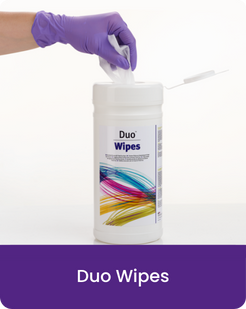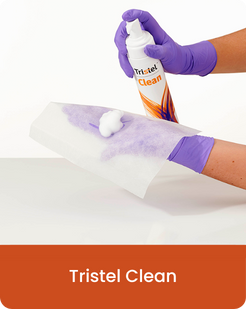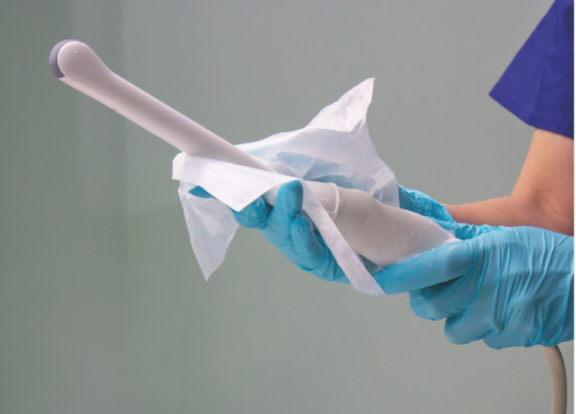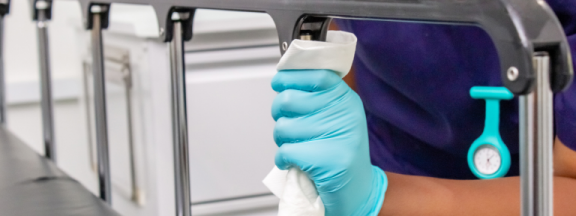If Good is Enough, Better is Possible!
Ultrasound continues to evolve as a portable service in healthcare; with new applications, in new clinical areas, and in the hands of new professionals. With every development comes new risk, and it is important that Infection Prevention and Control keeps up!
Under AS5369:2023, non-critical devices contact intact skin, and need cleaning followed by low-level or intermediate-level disinfection ‘where applicable’ or ‘where required’. But there is no guidance for facilities as to what the requirement is.
TRISTEL DUO NCU KILLS ALL MICROBIAL PATHOGENS EXCEPT BACTERIAL ENDOSPORES IN 30-SECONDS
What is an intermediate-level disinfectant?
![]()
An intermediate-level disinfectant is defined in the Australian Standard AS5369:2023 as a disinfectant that kills all microbial pathogens except bacterial endospores. While there is confusion (many believe it is just a marketing term!) intermediate-level disinfection (ILD) is a recognised process that is far superior to low-level disinfection (LLD) in terms of performance and efficacy. Non-critical devices can undergo either LLD or ILD at the user’s discretion.
Low-level disinfection (LLD) – Three bactericidal – One virucidal |
Intermediate-level disinfection (ILD) Range of bactericidal, virucidal, fungicidal and mycobactericidal tests at a minimum |
High-level disinfection (HLD) Same range as ILD with the addition of one sporicidal test and one simulated in use test |
Intermediate-level disinfection is far closer to the test requirements of high-level disinfection.
CONTACTING BLOOD? ILD HAS YOU COVERED!
Did you know that contact with blood or bodily fluids does NOT mean that high-level disinfection is required under AS5369:2023? The device remains non-critical, and you can choose LLD or ILD – with a broader range of efficacy, ILD can rise to the challenge of contamination!
Limitations of pre-wetted LLD Wipes
– Only required to pass bactericidal and some viricidal tests. – Usually contact times of 60-seconds or longer. – Many organisms of concern are not covered, or may have longer, unrealistic contact times. |
– Opening tubs and pulling wipes risks contamination of product. – Chemistry will have pooled at the bottom, leaving less on the top wipes. – How effective is the first wipe compared to the last? |
– Tubs and canisters can easily be left out, leading to wipes drying out, reducing efficacy and increasing wipes. |
– Poorly designed canisters sometimes lead to more wipes being pulled out, increasing cost and waste. |
– Validated to disinfect set surface area. – Larger areas require more wipes or risk reduced efficacy. |
One observational study comparing contamination rates of randomly swabbed stethoscopes and ultrasounds found that 17% of probes (as well as keyboards, handles and coupling gel) contained Gram negative bacteria and S. aureus, compared to 19% of stethoscopes.1
An Australian study looking at bacteria in ultrasound found that 60% of skin surface ultrasounds were positive for bacteria after use, and that 5% remained contaminated with a spore-forming species of bacteria after low-level disinfection.2
In an Australian study across five Emergency Departments and five ICUs, 57% of transducers were found to be contaminated with blood, and 46% with microbiological contamination. Of the samples that were positive for blood, only 51% were visibly stained.3
An Australian study looking at viral and fungal contamination of skin surface probes used for line insertion in a simulated setting found that HLD was not required, and LLD was sufficient. Gel was applied to probes, then were applied to the subject’s forearm without skin antisepsis, but there was no challenge with blood or other contaminants.4
DID YOU KNOW… The NCU in ‘Tristel Duo NCU’ stands for ‘Non-Critical Ultrasound? Tristel Duo NCU is not a generalised product, and was specifically developed for disinfection of ultrasound transducers. With compatibility with over 630 individual skin surface transducer models and counting!
Our Products
References
2 Westerway S, Basseal JM, Brockway A, Hyett JA, Carter DA. Potential risks associated with an ultrasound examination – a bacterial perspective. J Ultrasound Med Biol 2016; 43: 421–6
3 Keys M, Sim BZ, Thom O, Tunbridge MJ, Barnett AG, Fraser JF. Efforts to Attenuate the Spread of Infection (EASI): a prospective, observational multicentre survey of ultrasound equipment in Australian emergency departments and intensive care units. Crit Care Resusc. 2015 Mar;17(1):43-6. PMID: 25702761.
4 Peters N, Williamson F, Bauer MJ, Llewellyn S, Snelling PJ, Marsh N, Harris PNA, Stewart AG, Rickard CM. Comparison of Low-Level to High-Level Disinfection in Eliminating Microorganisms From Ultrasound Transducers Used on Skin: A Noninferiority Randomized Controlled Trial. J Ultrasound Med. 2023 Nov;42(11):2525-2534. doi: 10.1002/jum.16286. Epub 2023 Jun 12. PMID: 37306253






